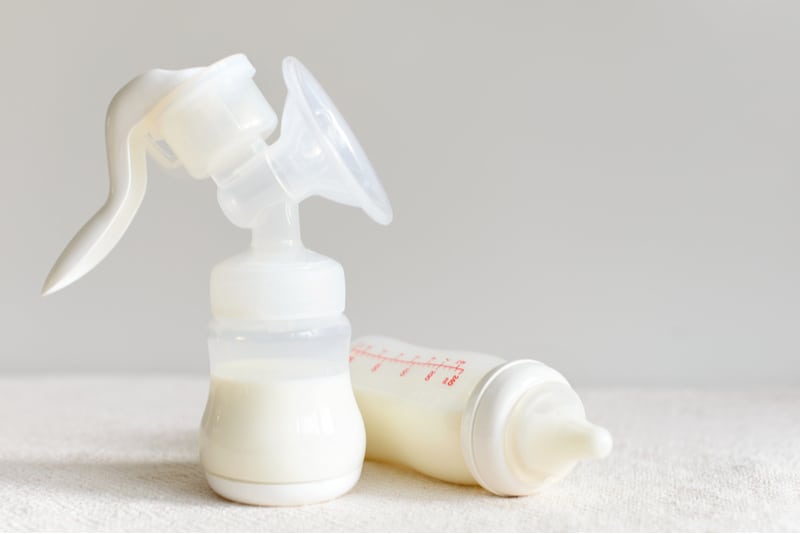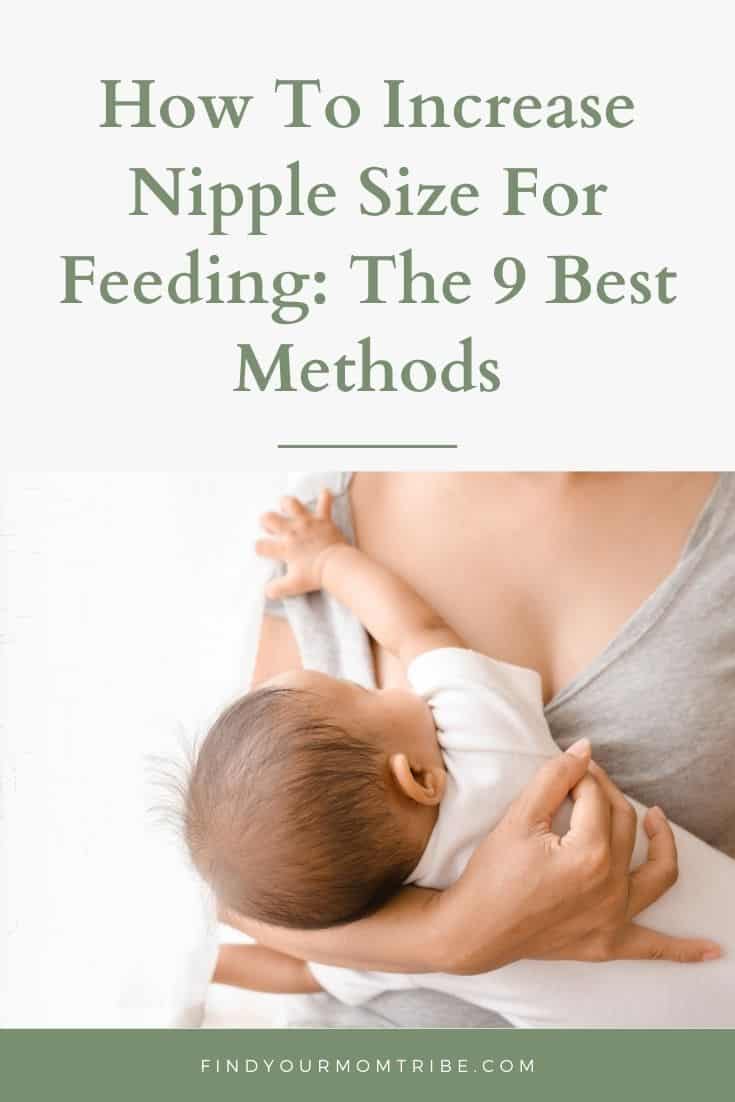New moms often worry about their lack of breastfeeding experience, especially when it comes to whether or not they’ll be able to produce enough milk for their baby.
However, the main concern is with nipple shape and size, so the most important question is how to increase nipple size for feeding?
When trying to work out how to increase nipple size for feeding, it’s best not to complicate things too much.
The only real concern is dealing with the baby swallowing air while breastfeeding, but even that is only a temporary issue which can be easily remedied.
The other important thing to keep in mind is the breastfeeding positions you are using.
Not only will this help improve your technique, but it will also assist in dealing with engorgement, a stunted milk supply, and any other issues with how your baby latches on.
That said, the size and shape of your nipples are equally important.
In general, there are three different types: a nipple that protrudes outward, an inverted nipple that comes out after some nipple stimulation, and a flat nipple.
Ultimately, the goal is to increase the nipple size (or surface) for your baby to easily latch onto, making milk flow easier.
Read on to discover how to achieve all this through tried and tested methods, which will help you resolve any issues you might be having while breastfeeding your child so you can get back to your regular feeding schedule as quickly as possible.
How To Increase Nipple Size For Feeding: 9 Foolproof Methods

1. Check what type of nipple you have
A common characteristic of any nipple is to protrude further than usual when undergoing nipple stimulation.
If you’re unsure whether your nipples protrude naturally, are flat, or inverted, you should give the pinch test a try.
Doing this little exercise will help you work out what your nipple type is.
You do this by first finding your areola, or the dark area around the nipple.
Once you do, place two fingers around it in a pinching fashion before squeezing gently on each nipple.
This should help coax the nipple forward, and is something that any breastfed baby should be capable of doing, so don’t squeeze too hard or you won’t accurately simulate your baby’s suction strength.
However, if this causes the nipple to retract or turn flat, then you have one of the other two types of nipples, which isn’t the end of the world, but will require a bit of extra work to make it easier for your baby to feed.
2. Hand express to relieve a flat nipple
Breast engorgement is one of the most common causes of flat nipples.
So, if you feel like your breasts are aching and full of milk, you may need to relieve some of that pressure.
This is done by hand-expressing enough milk to return the nipple to a protruding shape, which should relieve any aches it may have been causing for you.
It’s a very common issue in the postpartum period for new moms and will likely last for as long as you continue lactating, so don’t worry about it too much.
3. The use of breast shells and nipple shields
Nipple shields and breast shells are temporary aids in case you’re dealing with a particularly stubborn case of flat nipples.
Breast shells in particular are silicone-based circular objects which are placed over the nipple and the areola to help stimulate the nipple and draw it out, allowing for easier latching when it’s time to breastfeed.
They’re perfectly discreet and can also serve as protectors for cracked or sore nipples so your clothing doesn’t irritate them further.
Nipple shields, on the other hand, are similar, albeit with a slightly different purpose.
They take on the form of a nipple and are quite flexible, so they can fit any breast shape.
The shield goes over the same area as the shell, and serves as an extension to a flat nipple.
It’s a temporary solution to help you provide enough nutrition for your baby until your nipple shape returns to protruding once more.
However, while nipple shields are fantastic, there is some concern floating around between various breastfeeding experts and breastfeeding specialists regarding their use.
There is a worry that the shield may actually be counterproductive in aiding an engorged breast, or any other cause of flat nipples, as the breast may not be fully emptied.
The other concern is that a baby may form a level of nipple confusion, much like he could with a pacifier, to the point where he prefers the silicone breast over the real thing.
While these are only assumptions for now, it doesn’t change the fact that it’s very important to learn how to properly position the shields.
Poor handling and positioning can end up hurting your breast.
If you’re unsure how to properly place it, make sure to consult your lactation consultant (IBCLC) or any other qualified healthcare professional on the matter.
After all, a mother’s nipples are incredibly important for a baby’s first few years of life.
4. Make use of breast holds
There are two common ways of holding your breast to make breast latching easier for your little one; the C-hold and the V-hold, each named after the shape the fingers are in during the hold.
The C-hold is performed by forming a crescent “C” shape with the fingers around the breast, allowing for breast maneuverability and the flattening of its curvature, which makes it easier to fit in your baby’s mouth.
For a proper hold, you want your thumb to be on the top of the breast and behind the areola, gently squeezing down while the rest of the fingers are underneath squeezing in the opposite direction.
The best way to think about it is like you’re trying to hold a sandwich, except the food is for the baby, not you.
The V-hold, on the other hand, uses only two fingers, the index and the middle finger, to make a peace sign that you insert the nipple and areola between.
Go at it from the side so the thumb and index are above the nipple and areola while the others are underneath it, after which you want to press the index down gently until the nipple protrudes properly.
5. Using a breast pump for nipple stimulation

Either a manual or electric breast pump can help coax the nipple out if you’re having trouble because they can imitate a baby’s suction, or even perform a stronger one if need be.
They’re the go-to method for moms who have really stubborn inverted nipples that won’t come out unless you apply more force than your baby can muster.
A minute or so of breast pumping should get your breasts ready.
If you’re feeling up for it, or if you have an oversupply of milk, you may as well finish the pumping session and get some milk stored for bottle feeding later.
I’d even recommend this method for moms who like to stick to breastfeeding exclusively, in case no other method works.
You can think of the breast pump as your personal nipple protruder, rather than an actual pump.
That said, they can get expensive, so make sure to see if your health insurance might cover part of, or maybe even the whole purchase, so you can get your hands on one.
6. Alternate products that increase nipple size
There are other products on the market that aid in protruding an inverted nipple, known as either nipple retractors or nipple extractors.
There are a few other names you may find on sites such as Amazon, eBay, and the like, but most of them are basically the same thing.
Much like a breast shell, they can be worn under clothing inconspicuously while they work on pulling the nipple into the little protrusion designed for it.
While I personally have no experience with these, people have sworn that they work, though I suggest seeking advice from your lactation consultant on the product’s effectiveness before you buy it.
7. Practice pulling your breast tissue back
Another easy answer for how to increase nipple size for feeding, is to pull your breast tissue back.
It’s a simple trick, but very effective; simply try pulling the tissue where the nipple is hiding back to help it pop out.
While it won’t be as effective at first, making it part of your daily routine can help loosen the breast tissue over time, showing greater and greater results in the future and leading to a better latch for your baby.
The process is simple, all you have to do is take hold of the tissue located behind the areola of the breast and start gently pulling back toward yourself until the tissue pops the nipple out slightly.
8. Nipple stimulation
Another good tip is simple nipple stimulation. This is especially helpful for flat nipples as you can actually reach them, unlike in some cases of inverted ones.
Place the nipple between your thumb and index and gently roll it around to help stimulate it.
Alternatively, grab a cold, damp cloth to help stimulate it on a slightly larger area. Don’t get too chilly though.
Another method of stimulation is a special sort of nipple massage, dubbed the Hoffman technique.
This method was specifically constructed to help deal with inverted and flat nipples.
You start by holding the nipple between the index finger and thumb, before pressing back into the breast tissue.
Once there, pull away from the nipple with your two fingers to help stretch the areola before returning back toward the nipple.
If there is no discomfort you can repeat the process about five times, after which you should feel some relief and your nipple should protrude outward.
9. Seek expert advice
If none of the above methods work and you continue to experience severe pain or any other type of discomfort, it’s always best to talk to your family doctor or IBCLC.
They’re best qualified to help determine what might be wrong and the best way to remedy any potential issues.
It’s important to be aware that, while rare, some complications may require surgery.
Depending on the issue, some surgeries can remove your milk ducts, which will leave you unable to lactate properly.
Thankfully, alternatives do exist where you’ll still be able to feed your baby, but that depends on the issue in question.
Make sure to talk to your doctor about the best route to take and, if presented with the worst-case scenario, if there’s a solution that will allow you to feed your baby afterward.
How To Tell If Your Baby Is Getting Enough Milk

The best way to figure out if your little one is getting proper nutrition from your breast milk is by keeping track of his dirty diapers.
If he poops around 3 or more times and has around 6 wet diapers per day, he’s doing a great job!
What If My Nipples Are Too Small To Breastfeed?
The size of your nipples doesn’t matter when it comes to breastfeeding, only their protrusion.
Most babies will be able to nurse regardless of their size as long as they latch on properly and get plenty of skin-to-skin contact.
In Conclusion
Learning how to increase nipple size for feeding when you have flat or inverted nipples isn’t too hard, it just requires a little bit of research.
Most of the methods involved are easy to perform anywhere and don’t require any extra products, outside of the breast pump or shell methods.
If possible, try solutions that don’t require the aid of products first and see if they work, then attempt the others.
Whatever the case, I suggest talking with your lactation consultant first.
They may be able to find out exactly what the issue is and what the best method for you is going to be to get your nipples to protrude outwards for feeding.
I’m sure that you’ll figure it out yourself too, though.
Until next time, mamas!
References:
• Selina C., Ronald C., Edward C., Marko P., Jelena P., Mila P., Henry L., Michael L., Joav M., Søren V., 2015, Oct 16, The Use of Nipple Shields: A Review, Front Public Health
Like this post? Please share or pin it for later. You can also stay in the loop and follow us on Facebook, Instagram or Pinterest.


